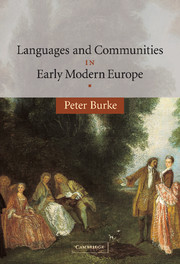Book contents
- Frontmatter
- Contents
- Acknowledgements
- Chronology 1450–1794
- Prologue: communities and domains
- 1 ‘Speak, that I may see thee’: the discovery of language in early modern Europe
- 2 Latin: a language in search of a community
- 3 Vernaculars in competition
- 4 Standardizing languages
- 5 Mixing languages
- 6 Purifying languages
- Epilogue: languages and nations
- Appendix: languages in Europe 1450–1789
- Bibliography
- Index
Epilogue: languages and nations
Published online by Cambridge University Press: 07 December 2009
- Frontmatter
- Contents
- Acknowledgements
- Chronology 1450–1794
- Prologue: communities and domains
- 1 ‘Speak, that I may see thee’: the discovery of language in early modern Europe
- 2 Latin: a language in search of a community
- 3 Vernaculars in competition
- 4 Standardizing languages
- 5 Mixing languages
- 6 Purifying languages
- Epilogue: languages and nations
- Appendix: languages in Europe 1450–1789
- Bibliography
- Index
Summary
This book has presented a few central themes in the story of European languages from the late-fifteenth to the late-eighteenth century. The choice of the French Revolution as the moment to end the story implies that in language, as in government, an old regime was replaced by a new one after 1789.
Roughly speaking, this view is correct. From 1789 onwards, governments in Europe and elsewhere have become increasingly concerned with the everyday language of ordinary people. The point is that language both expresses and helps to create national communities. We might say that language was ‘nationalized’ at this time, or that it became an instrument of the ‘cult of the nation’. From this time onward, it becomes appropriate to speak of conscious ‘language policies’.
To be more precise, though, this view requires a few qualifications. As so often in history, it is more illuminating to view change in relative terms than in absolute ones, to speak of more or less rather than of presence or absence. Cultural regimes are not transformed overnight, or even in a decade. Changes in the linguistic regime and the idea of the nation were becoming visible before the Revolution and continuities remained apparent long after that date. This is the reason for the following epilogue. It does not aspire to be a general survey of European languages in the last two centuries. It is simply intended to offer a few explicit comparisons and contrasts between European languages and their communities before and after 1789.
- Type
- Chapter
- Information
- Languages and Communities in Early Modern Europe , pp. 160 - 172Publisher: Cambridge University PressPrint publication year: 2004

